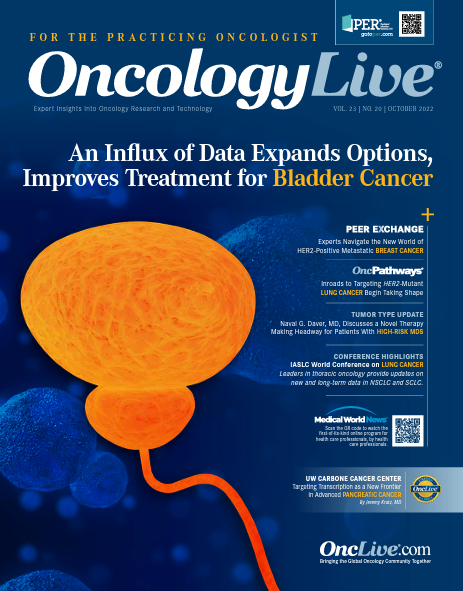Publication
Article
Oncology Live®
Experts Navigate the New World of HER2-Positive Metastatic Breast Cancer
Author(s):
Treatment decisions in the second-line setting for patients with HER2-positive metastatic breast cancer are not as cut-and-dried as deciding between which data have the best outcomes.
William J. Gradishar, MD

Treatment decisions in the second-line setting for patients with HER2-positive metastatic breast cancer are not as cut-and-dried as deciding between which data have the best outcomes.
Nuances in patient populations, toxicity profiles, and sequencing considerations following disease progression in later lines of therapy are playing a larger role as new data mount. Adaptability will be key for oncologists in the coming years. been generated are going to move the sequence,” Gradishar said. “It’s going to be different 1 year from now, and 2 years from now. What we have learned with confidence is that things are going to change.” “What I am struck by is every time we go to the ASCO [American Society of Clinical Oncology Annual Meeting] or San Antonio [Breast Cancer Symposium], we compare the new data to the time when we started our careers....We fiddled with the handful of chemotherapy drugs we had and maybe the schedule. That was the big question at every meeting,” William J. Gradishar, MD, said. “Now we have new drugs, we understand more nuance or maybe we don’t understand, and we are trying to figure out how to use these drugs optimally, and that’s really exciting—to juxtapose those 2 time periods.”
In an OncLive Peer Exchange®, breast cancer experts reviewed the clinical data that are reshaping approaches to metastatic HER2-positive breast cancer. The panelists illustrated how the treatment paradigm is likely to undergo waves of transformation for years to come given the surge of new agents demonstrating clinical benefit. “We haven’t learned a whole lot about sequencing because I think if anything all the data that have been generated are going to move the sequence,” Gradishar said. “It’s going to be different 1 year from now, and 2 years from now. What we have learned with confidence is that things are going to change.”
The Classics Remain
Andrew D. Seidman, MD

One area of unshakable stability is in the frontline setting for patients with HER2-positive metastatic disease. The phase 3 CLEOPATRA study (NCT00567190) provided the foundation for patients with previously untreated metastatic disease with the regimen of pertuzumab (Perjeta), trastuzumab (Herceptin), and docetaxel. “It’s been approximately a decade since the publication of CLEOPATRA—taxane, trastuzumab, and pertuzumab has been a mainstay of treatment,” Andrew D. Seidman, MD, said. Data published in 2020 demonstrated that at 99.9 months’ follow-up, the median overall survival (OS) for patients who received pertuzumab, trastuzumab, and docetaxel was 57.1 months (95% CI, 50.0-72.0) compared with 40.8 months (95% CI, 36.0-48.0) with placebo, trastuzumab, and docetaxel (HR, 0.69; 95% CI, 0.58-0.82). The 8-year OS rates were 37% (95% CI, 31%-42%) and 23% (95% CI, 19%-28%), respectively.1
Tiffany A. Traina, MD

This is a great regimen; it’s our standard of care,” Tiffany A. Traina, MD, said, adding that paclitaxel is also a reasonable backbone for use in the combination. “Where I give some pause is in my patients who unfortunately had neoadjuvant or adjuvant taxane and have had a really short disease-free interval— less than 6 months, even less than a year,” she said. “Fortunately, we’re not seeing this as much as we used to, because of our impressive agents available in the early-stage setting. But this is where there is an opportunity for antibody-drug conjugates [ADCs] that we have for HER2-positive disease.”
Challenging the Second Line
Following disease progression, the traditional approach to care was ado-trastuzumab emtansine (T-DM1; Kadcyla).2 Findings from the phase 3 EMILIA trial (NCT00829166) demonstrated that the ADC outperformed capecitabine and lapatinib (Tykerb) in patients with HER2positive, metastatic breast cancer who previously received trastuzumab and a taxane. However, after impressive data brought fam-trastuzumab deruxtecan-nxki (Enhertu) to the third and later lines of therapy, the natural next step was to test the agent’s efficacy against the long-standing standard of care in the second line.
Vijayakrishna Gadi, MD, PhD

“T-DM1 was the first drug to take that mantle,” Vijayakrishna Gadi, MD, PhD, said. “Recently, we’ve got these exciting data with the trastuzumab deruxtecan in that space, a randomized clinical trial comparing trastuzumab deruxtecan to T-DM1. If you recall, that had 22 zeros in the P value [7.8 × 10–22]. When was the last time we saw a drug approval trial with 22 zeros?” Investigators of DESTINY-Breast03 (NCT03529110) pitted T-DM1 head-to-head with trastuzumab deruxtecan among 524 randomly assigned patients. The 12-month progression-free survival rate was 75.8% with trastuzumab deruxtecan (n = 261) compared with 34.1% with T-DM1 (n = 263; HR, 0.28; 95% CI, 0.22-0.37; P < .001).3 “There were superior PFS data, and a hint of an OS [advantage] already, although events are still occurring,” Gadi said, adding that safety data presented at the 2022 ASCO meeting showed that different analyses reflect another avenue for success with the newcomer.
“Depending on how you analyze the safety data, you could make the case that given the exposure time, individuals who are benefiting from a drug are going to be on it for longer,” Gadi said. “When you amortize the toxicity over that time frame, you can create ratios that suggest T-DM1 was more toxic in some scenarios and some cases.” The safety update had a cutoff date of September 7, 2021, and the median treatment durations for trastuzumab deruxtecan and T-DM1 were 16.1 months and 6.9 months, respectively.4 Interstitial lung disease (ILD), an adverse effect (AE) of special interest with trastuzumab deruxtecan, was included in the prespecified analysis of treatment-emergent AEs (TEAEs) with nausea, vomiting, fatigue, alopecia, and hematologic events. At the cutoff, 54.9% of patients who received trastuzumab deruxtecan on study (n = 257) discontinued treatment compared with 85.1% of patients who received T-DM1 on study (n = 261). The rates of TEAEs of any grade and grade 3 or higher were similar between the 2 treatment arms. TEAEs that led to treatment discontinuation were reported in 38 and 19 patients, respectively. Dose reductions due to TEAEs were also more prevalent in the trastuzumab deruxtecan arm (23% vs 13.8%, respectively).4 The exposure-adjusted incidence rates (EAIRs) were measured to account for the differences in the treatment durations for the 2 agents. Using this analysis, the EAIRs per patient year were lower in the trastuzumab deruxtecan arm vs the T-DM1 arm except for TEAEs with drug discontinuation. These were primarily associated with ILD/pneumonitis in the trastuzumab deruxtecan (TABLE).4
Table. EAIRs in DESTINY-Breast03

“We’re getting comfortable with trastuzumab deruxtecan and it’s now the preferred agent for a lot of patients in the second-line setting,” Gadi added.
Case Scenario: Prior Lung Disease
Stephanie L. Graff, MD

In offering a clinical scenario for discussion, Seidman said a patient presented with diffusing capacity of 73% from an undetermined source, possibly interstitial pneumonitis from a prior therapy, and asked whether a pulmonary test would be required before administering trastuzumab deruxtecan. “The problem is that we just don’t know who is going to develop ILD with trastuzumab deruxtecan,” Stephanie L. Graff, MD, said. “The updated safety data from DESTINY-Breast03 showed that 10.9% of patients developed ILD and the vast majority of that was grade 1 and grade 2. For those of you that don’t live and breathe the clinical trial AE profiles, grade 1 ILD means infiltrates, so no chest x-ray with no symptoms, which in a global pandemic of lung diseases is 10% grade 1 pneumonitis, it’s hard to put that into context. As the DESTINY-Breast portfolio has evolved, the rate of ILD has gotten better, certainly not worse, which is a testament to our learning curve as investigators, as a medical oncology community with the drug.”
Pulmonary concerns were a common issue; the panel noted that as discussions in the community moved from the virtual environment to in-person gatherings, the real-world experiences of patients in the clinic came to light. “In the last year talking to physicians in the community, if they had a patient with lung metastases, one of the misconceptions we want to dispel is that you shouldn’t give [trastuzumab deruxtecan] but it’s the opposite,” Gradishar said. “When you have bulky visceral disease, those are the patients most likely to benefit.” Graff concurred, adding, “It’s a risk-benefit discussion with the patient on what you want to consider and try. I certainly would be monitoring those patients more carefully.”
Brain Metastasis Activity Signals
Beyond pulmonary concerns, the panel discussed brain metastases and how the emergence of newer agents looks to give the combination of tucatinib (Tukysa), trastuzumab, and capecitabine a challenge. The final HER2CLIMB trial (NCT026147942) OS analysis for example demonstrated that the combination improved outcomes compared with trastuzumab/capecitabine alone in patients with HER2-positive metastatic breast cancer who had stable or active brain metastases.5 At a median follow-up of 29.6 months, the addition of tucatinib resulted in a median OS of 21.6 months (95% CI, 18.1-28.5) vs 12.5 months (95% CI, 11.2-16.9) with trastuzumab and capecitabine alone in patients with active and stable brain metastases (n = 291; HR, 0.60; 95% CI, 0.44-0.81).
Among patients with active brain metastases (n = 174), the tucatinib regimen resulted in a median OS of 21.4 months (95% CI, 18.1-28.9) vs 11.8 months (95% CI, 10.3-15.2) with trastuzumab and capecitabine alone (HR, 0.52; 95% CI, 0.360.77). Among those with stable brain metastases (n = 117), the median OS was 21.6 months (95% CI, 15.3-42.4) vs 16.4 months (95% CI, 10.6-21.6), in the experimental and control arms, respectively (HR, 0.70; 95% CI, 0.42-1.16).
Those with stable and active brain metastases who received the addition of tucatinib experienced an improvement in median central nervous system (CNS)-PFS compared with trastuzumab/ capecitabine alone, at 9.9 months (95% CI, 8.4-11.7) and 4.2 months (95% CI, 3.6-5.7), respectively (HR, 0.39; 95% CI, 0.27-0.56).5
“What was wonderful to see was that patients receiving the triplet had improved OS and that included the population with brain metastasis,” Traina said. “That benefit has been quite durable, so there are not only responses but improved PFS and improved OS for the overall study population as well as those patients with brain metastasis.” Moreover, the median CNS-PFS for those with active brain metastases was 9.6 months (95% CI, 7.6-11.1) vs 4.0 months (95% CI, 2.9-5.6) in the tucatinib and placebo arms, respectively (HR, 0.34; 95% CI, 0.22-0.54). Those with stable brain metastases experienced a median CNS-PFS of 13.9 months (95% CI, 9.7-24.9) with the tucatinib triplet vs 5.6 months (95% CI, 3.0–not evaluable) with trastuzumab/capecitabine (HR, 0.41; 95% CI, 0.19-0.85). Traina said these data raise questions concerning when local intervention with radiation is warranted if there is an opportunity to use a effective systemic therapy with blood-brain barrier penetration.
In a subgroup analysis of DESTINY-Breast03, investigators reported outcomes for patients with brain metastases. At a median follow-up of 15.9 months, the median PFS was 15.0 months (95% CI, 12.5-22.2) with trastuzumab deruxtecan vs 3.0 months (95% CI, 2.8-5.8) with T-DM1 (HR, 0.25; 95% CI, 0.13-0.45). The 12-month PFS rates were 72.0% (95% CI, 55.0%-83.5%) vs 20.9% (95% CI, 8.7%-36.6%), respectively.
The confirmed ORR was 67.4% (95% CI, 51.5%80.9%) with trastuzumab deruxtecan vs 20.5% (95% CI, 9.3%-36.5%) with T-DM1. Among patients without brain metastases, the confirmed ORR was 82.1% (95% CI, 76.4%-87.0%) vs 36.6% (95% CI, 30.3%-43.3%), respectively.
Notably, patients with brain metastases experienced a lower rate of progressive disease with trastuzumab deruxtecan vs T-DM1, at 48.8% vs 69.2%, respectively.
Regarding intracranial responses, the complete response rate was 27.8% with trastuzumab deruxtecan vs 2.8% with T-DM1. The intracranial partial response rates were 36.1% vs 30.6%, respectively. Trastuzumab deruxtecan also led to a lower rate of intracranial progressive disease vs T-DM1, at 2.8% vs 22.2%, respectively.6
Finally, primary outcome analysis of the phase 2 TUXEDO-1 trial (NCT04752059) also supported the use of trastuzumab deruxtecan for patients with brain metastases with an ORR via response assessment in neuro-oncology criteria of 73.3% (95% CI, 48.1%-89.1%).7 However, the data were only presented for 15 patients. Seidman noted that regardless of population size, this was an interesting signal of CNS efficacy.
“We have a lot of options, but the question could be better posed: Do we have evidence that one sequence is better than another?” Gradishar said. “Therein lies the lack of the data. Patients are getting the CLEOPATRA regimen, they may have gotten trastuzumab deruxtecan as their second line, and then what comes next?” He added that the National Comprehensive Cancer Network guidelines are a good starting point for these treatment decisions but that not all supporting data have information for patients treated with some of the newer regimens.“
Tucatinib trial was evaluated in a randomized phase 3 trial with survival benefit, but it didn’t look at patients who had gotten trastuzumab deruxtecan before, but I would view that as a pretty strong piece of evidence that that would be a reasonable approach,” he said. “There are other options, of course. You could switch out chemotherapy or continue trastuzumab with a variety of agents. You could give neratinib [Nerlynx]. These would not be my first choices. I would use the HER2CLIMB regimen preferentially before then but the caveat is not every patient can tolerate it.”
Case Scenario: Brain Metastases
Approaches to brain metastases, as Gradishar pointed out, are not cut-and-dried and may require a multidisciplinary approach to care.
In a case scenario, Seidman posed: “At the time of progression there is suspicion of CNS disease in a patient who has progressed on trastuzumab deruxtecan as her second-line regimen after having had CLEOPATRA therapy in the first line. On an MRI she had 2 subcentimeter lesions and it is not clear if they were causing her symptoms. You’re going to send her for stereotactic radiation. Are you going to try HER2CLIMB and see whether you get a CNS response in the asymptomatic oligometastatic patient? Are you going to give T-DM1?”
Gadi noted that if there were disease control below the neck, he would retain the previous agent and target the CNS metastases with stereotactic radiosurgery. “If she is progressing below the neck and above the neck, that’s frightening because below the neck progression is strongly correlated with additional brain metastases,” he said. “Maybe target the CNS directly with stereotactic surgery and radiosurgery and then move on to the HER2CLIMB regimen for that patient—or, even better, if we have a clinical trial to explore some combinations in that setting, I might do both.”
What Does Progress Mean?
Graff noted that although the agents have a place, it is not fully transparent. “Approved therapies such as trastuzumab deruxtecan and tucatinib keep fighting to move earlier and earlier; I am lucky to practice in an environment where I have those agents on trials in those settings and we’re seeing patients stay on them longer.” Graff added that this raises the question about what to do with T-DM1.
“If I am moving trastuzumab deruxtecan earlier in my portfolio of treatment, when am I putting T-DM1 back in the sequence? Because of the pattern of visceral metastasis and brain metastasis, is hard to know if patients with HER2-positive disease are going to get fifth, sixth, or seventh line of therapy especially after heavy pretreatment, and long durations of therapy with effective HER2 ADCs.” After these agents, Graff added, she would pick among neratinib, lapatinib, and margetuximab-cmkb (Margenza) as her next line of therapy. “The answer is somewhere in the data,” she said. “I am choosing based on the medications we are using in combination and the toxicity profile relative to the patient as well as their risk of AEs.”
As for what’s next, Traina said, “I hopefully will be on a panel in a couple of years reporting out data from new agents, but it’s tough for the new agents that are being explored because they are designed to treat individuals who have previously seen drugs such as trastuzumab, trastuzumab deruxtecan, or tucatinib. It’s going to be a high bar to show benefit there.”
References
- Swain SM, Miles D, Kim SB, et al; CLEOPATRA study group. Pertuzumab, trastuzumab, and docetaxel for HER2-positive metastatic breast cancer (CLEOPATRA): end-of-study results from a double-blind, randomised, placebo-controlled, phase 3 study. Lancet Oncol. 2020;21(4):519-530. doi:10.1016/S1470-2045(19)30863-0
- Diéras V, Miles D, Verma S, et al. Trastuzumab emtansine versus capecitabine plus lapatinib in patients with previously treated HER2-positive advanced breast cancer (EMILIA): a descriptive analysis of final overall survival results from a randomised, open-label, phase 3 trial. Lancet Oncol. 2017;18(6):732-742.
doi:10.1016/S1470-2045(17)30312-1 - Cortés J, Kim SB, Chung WP, et al; DESTINY-Breast03 Trial Investigators. Trastuzumab deruxtecan versus trastuzumab emtansine for breast cancer. N Engl J Med. 2022;386(12):1143-1154. doi:10.1056/NEJMoa2115022
- Hamilton EP, Bragaia VPH, Yeo W, et al. Trastuzumab deruxtecan (T-DXd) vs trastuzumab emtansine (T-DM1) in patients (pts) with HER2-positive (HER2+) unresectable and/or metastatic breast cancer (mBC): safety follow-up of the randomized, phase 3 study DESTINY-Breast03. J Clin Oncol. 2022;40(suppl 16):1000. doi:10.1200/JCO.2022.40.16_suppl.1000
- Curigliano G, Mueller V, Borges V, et al. Tucatinib versus placebo added to trastuzumab and capecitabine for patients with pretreated HER2+ metastatic breast cancer with and without brain metastases (HER2CLIMB): final overall survival analysis. Ann Oncol. 2022;33(3):321-329. doi:10.1016/j.annonc.2021.12.005
- Hurvitz S, Kim SB, Chung WP, et al. Trastuzumab deruxtecan (T-DXd; DS-8201a) vs. trastuzumab emtansine (T-DM1) in patients (pts) with HER2+ metastatic breast cancer (mBC): subgroup analyses from the randomized phase 3 study DESTINY-Breast03. Cancer Res. 2022;82(suppl 4):GS3-01. doi:10.1158/1538-7445.SABCS21-GS3-01
- Bartsch R, Berghoff AS, Furtner J, et al. Trastuzumab deruxtecan in HER2-positive breast cancer with brain metastases: a single-arm, phase 2 trial. Nat Med. 2022;28(9):1840-1847. doi:10.1038/s41591-022-01935-8

Latest Conference Coverage

Zongertinib Elicits Durable Responses in Pretreated Advanced HER2-Mutant NSCLC

Lenvatinib Shows Efficacy in Advanced HCC Post-Progression on Atezolizumab/Bevacizumab

Sacituzumab Govitecan Does Not Significantly Improve OS in Pretreated Urothelial Carcinoma

Active Monitoring Is Noninferior to Guideline Concordant Care in Low-Risk DCIS
2 Commerce Drive
Cranbury, NJ 08512





